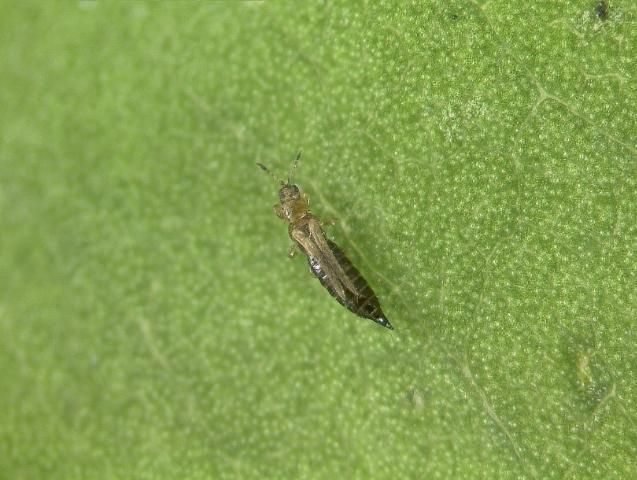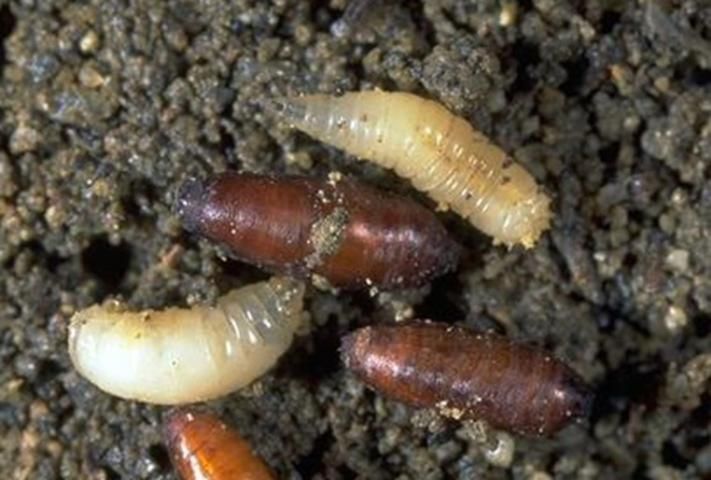Sweet varieties of bulbing onions, which make bulbs under short day conditions and do not store well, are the most common onions grown in Florida. They are generally grown on small acreages in the winter for local and farmers markets.
The onion crop in Florida has relatively few insect pests because it is grown in the winter and early spring, with thrips and seedcorn maggot being the most commonly found. Armyworms and cutworms can occasionally damage seedlings. Cultural controls, such as growing thrips-tolerant varieties or late planting for maggot prevention, should be used, and insecticides should be avoided as much as possible to limit the development of insecticide resistance and favor the survival of insect predators and parasitoids. Pesticides labeled for onion, leek and garlic can be found in the updated annual UF/IFAS Vegetable Production Handbook.
Thrips
Several species of thrips feed on onions. In north Florida, onion thrips (Thrips tabaci) and tobacco thrips (Frankliniella fusca, Figure 1) are the most common. Onion thrips can transmit Iris yellow spot virus, and tobacco thrips transmits Tomato spotted wilt virus to onions. Other thrips, including the western flower thrips (F. occidentalis) and melon thrips (T. palmi), have been reported to attack onions. Thrips can become resistant to insecticides very quickly. Because they feed deep down at the base of emerging leaves, they can also avoid both insecticides and natural enemies, such as the insidious pirate bug. There are relatively few insecticides labeled for use on onions. The most commonly used are the pyrethroids and methomyl, a carbamate, but they may be only moderately effective. Diamides (such as cyantranilipore), and spirotetramat have been shown to be effective against thrips in onion. To sample for thrips in onion, tapping is the most time-effective strategy. Place a white board below the onion foliage and vigorously shake leaves above the board. The thrips will be dislodged, will fall on the white board, and can be counted directly. Thrips with a black body color falling on the board are most likely tobacco thrips (F. fusca); the others will need to be identified under a microscope. To collect thrips, aspirate them with a mouth aspirator when they fall on the white board during tapping, and preserve them in alcohol. Send them to your local scout or Extension agent for identification. An action threshold of 5 to 10 thrips per plant has been suggested for winter-grown sweet onions.

Credit: Lyle Buss, UF/IFAS
Seedcorn Maggot
http://entnemdept.ufl.edu/creatures/FIELD/CORN/seedcorn_maggot.htm
Eggs are white, elongated, 1/16 inch long, and deposited among the debris that collects around plant stems near the soil surface. The maggot is pale yellowish-white and ¼ inch long and pupates in the soil. The adult is a brownish-gray fly resembling a house fly but half the size; they can be found commonly in the fall, early winter, and spring season. Seedcorn maggot feeds on more than 40 different host plants and can be a problem when there are high levels of decaying organic matter in the soil and when the weather is cool and wet. Seedcorn maggots feed primarily on seedlings and up to the 3 to 4 leaf stages. Cultural control practices may be used to decrease the impact of seedcorn maggot and include avoiding fields with high amounts of organic matter and no-till seedling. Because seedcorn maggot feeds mainly on seedlings, planting onions in conditions that promote rapid onion development (such as late planting) should minimize damage. Seedcorn maggot populations can be monitored with yellow sticky traps positioned above the onion foliage. Soil applications of chlorpyrifos or diazinon at planting may be useful if there is a history of seedcorn maggot problems. Early preparation of the field to allow the breakdown of organic matter before planting is essential.

Credit: Jack Kelly Clark (UC Riverside)
There is another maggot for onion in the United States, the onion maggot Delia antiqua. This is a major pest of onion in northeastern United States, but it is not established in Florida.